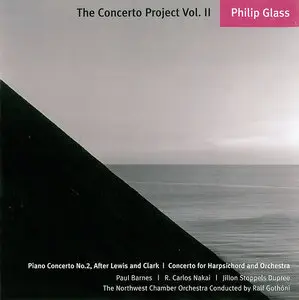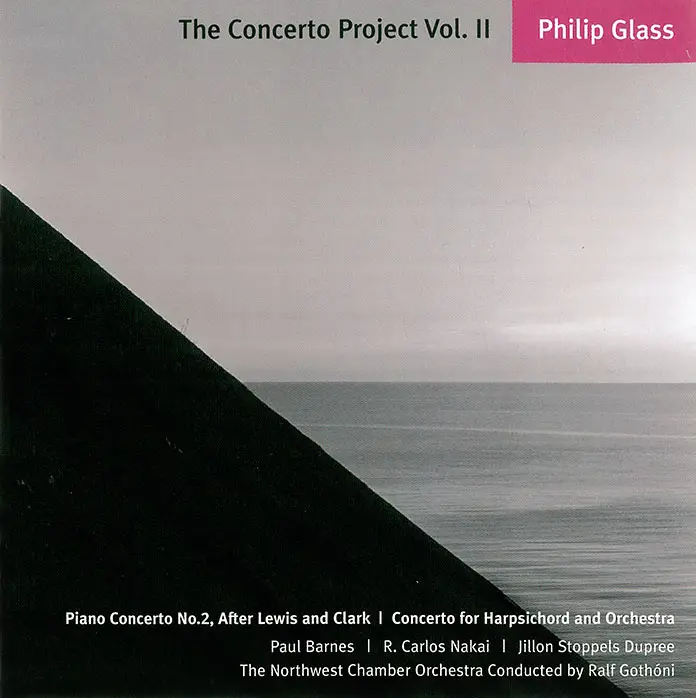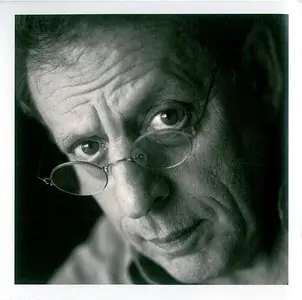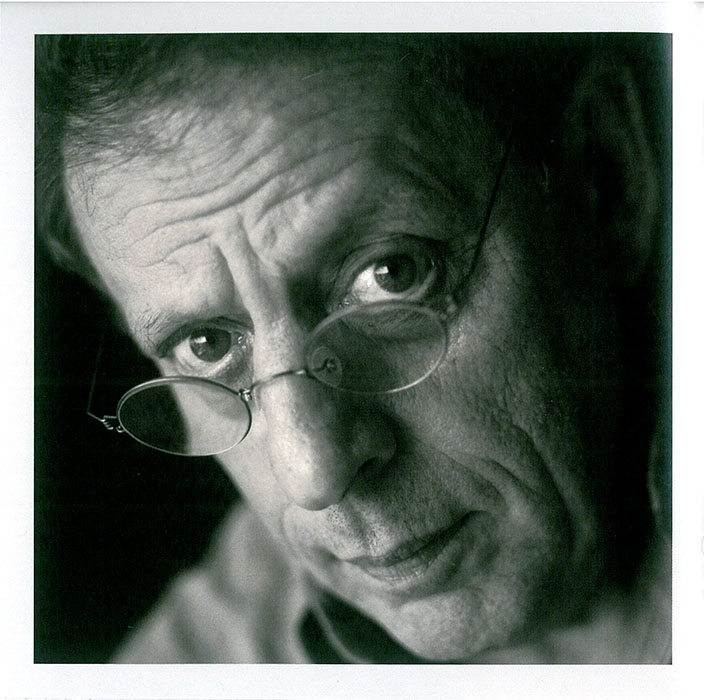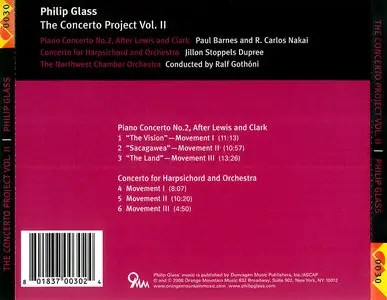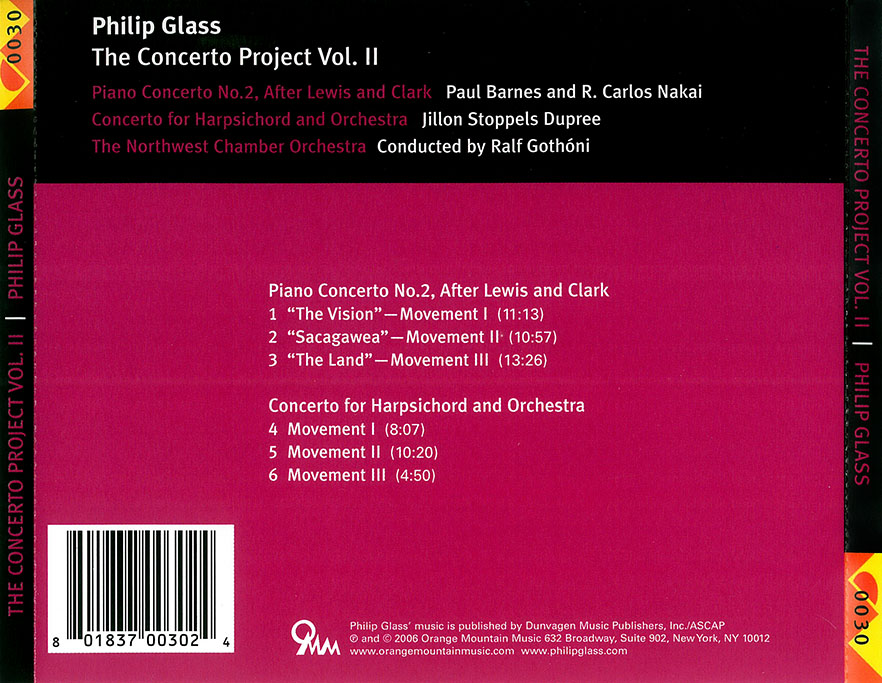Philip Glass - The Concerto Project Vol. II (2006)
Piano Concerto No. 2; Concerto for Harpsichord and Orchestra
Paul Barnes, piano; R. Carlos Nakai, flute; Jillon Stoppels Dupree, harpsichord
Northwest Chamber Orchestra; Ralf Gothóni, conductor
EAC | FLAC | Image (Cue&Log) ~ 304 Mb | Mp3 (CBR320) ~ 163 Mb | Scans included
Classical, Minimalism | Label: Orange Mountain Music | # 0030 | Time: 00:42:30
Piano Concerto No. 2; Concerto for Harpsichord and Orchestra
Paul Barnes, piano; R. Carlos Nakai, flute; Jillon Stoppels Dupree, harpsichord
Northwest Chamber Orchestra; Ralf Gothóni, conductor
EAC | FLAC | Image (Cue&Log) ~ 304 Mb | Mp3 (CBR320) ~ 163 Mb | Scans included
Classical, Minimalism | Label: Orange Mountain Music | # 0030 | Time: 00:42:30
The second release in Orange Mountain Music's 'Concerto Project' series features two world premiere recordings of works by Philip Glass, performed by the Seattle-based Northwest Chamber Orchestra under Ralf Gothóni (well-known to UK audiences as Principal Conductor of the English Chamber Orchestra since 2000).
Pianist Paul Barnes performs Piano Concerto No2, After Lewis and Clark written to celebrate the 200th anniversary of the explorers' journey across the American continent. A fortuitous meeting between Barnes and Glass on an airplane in 1995 eventually led to this concerto, but it was only composed after Orange Mountain Music's acclaimed 2003 release of the pianist's transcriptions of Glass operas 'The Orphee Suite'.
The opening movement, 'The Vision', is described by Glass as a "musical steamroller" and depicts the tremendous resolve and energy required by Lewis and Clark for their extraordinary expedition, while the last of the three movements, 'The Land', is a gloriously expansive theme and variations reflecting the great vastness of the land they explored. In between comes 'Sacagawea', an intimate movement that features a traditional Shoshone Indian theme performed on the Native American flute by renowned player R Carlos Nakai.
The dynamic flare of the piano concerto is contrasted by the album's second work, Glass's beautiful Concerto for Harpsichord and Orchestra. The three-movement work is played by harpsichordist Jillon Stoppels Dupree, one of America's top baroque musicians. She says it is "captivating, stunningly beautiful and mesmerizing in the best sense of the word…Though it is certainly recognizable as Glass, with its hypnotic arpeggiation in the first movement and its haunting melodic gestures in the second, in many ways it surprises with elements of both jazz and baroque styles. (It) is frolicking fun to play."
The piece is marked by refined writing for chamber orchestra which showcases the most lush sounds of the harpsichord, the Seattle Post-Intelligencer raved: "The whole well designed work had life and shape and a beautiful balance between soloist and orchestra" while the Seattle Times said that Glass "understands how to score for the harpsichord, giving the soloist plenty of trills and other effects that demonstrate its melodic as well as percussive possibilities."
Philip Glass has always been canny about finding venues for his music, and this has helped him realize large-scale projects like his operas of the 1970s and 1980s. In the years since then, even if he has not made something personal about his minimalist language in the way that his contemporary Steve Reich has, he has realized that his style can be inflected back in the direction of traditional classical forms and made to suit most any occasion. The two keyboard concertos recorded here provide pleasing examples. Neither one is a concerto in the usual sense, with the soloist defining an independent identity. Instead the keyboardists in both works generally provide Glass' trademark pulse, and in the outer movements they rarely get a rest. In the Piano Concerto No. 2, After Lewis and Clark, the most effective movement is the central "Sacagawea," evoking the Shoshone woman, pictured on the U.S. dollar coin, who saved the bacon of the two explorers. The movement is constructed around two flute themes, one of them of Shoshone origin, played here by renowned Native American flutist R. Carlos Nakai; they add something of the element of reverence that made Glass' film score Koyaanisquaatsi so successful. In the Concerto for harpsichord and orchestra Glass skillfully exploits the surface similarities between Baroque motor rhythms and his own basic procedures, using bits of jazz syncopation and some quasi-improvisatory passages, all in all creating a joyous, kinetic foot-tapper. Harpsichordist Jillon Stoppels Dupree gets into the enthusiastic spirit of the work, and conductor Ralf Gothóni, leading the Northwest Chamber Orchestra, keeps the energy level up without overwhelming the harpsichord – an aspect of the work that apparently gave Glass problems as the premiere performance (featuring these same forces) took shape. Listeners who have enjoyed hearing their local orchestras undertake one of Glass' growing catalog of symphonies would do well to try this variation on a theme.Review by James Manheim, Allmusic.com
Tracklist:
Piano Concerto No. 2, After Lewis and Clark
01. 'The Vision' - Movement I (11:13)
02. 'Sacagawea' - Movement II (10:57)
03. 'The Land' - Movement III (13:28)
Concerto for Harpsichord and Orchestra
04. Movement I (08:07)
05. Movement II (10:20)
06. Movement III (04:50)
Exact Audio Copy V1.0 beta 1 from 15. November 2010
EAC extraction logfile from 13. September 2011, 21:38
Philip Glass / The Concerto Project Vol. II
Used drive : Optiarc DVD RW AD-7203A Adapter: 4 ID: 1
Read mode : Secure
Utilize accurate stream : Yes
Defeat audio cache : Yes
Make use of C2 pointers : No
Read offset correction : 48
Overread into Lead-In and Lead-Out : No
Fill up missing offset samples with silence : Yes
Delete leading and trailing silent blocks : No
Null samples used in CRC calculations : Yes
Used interface : Native Win32 interface for Win NT & 2000
Used output format : User Defined Encoder
Selected bitrate : 128 kBit/s
Quality : High
Add ID3 tag : No
Command line compressor : C:\Program Files\FLAC\flac.exe
Additional command line options : -T "COMMENT=Ripped by GFox" -8 -V %s
TOC of the extracted CD
Track | Start | Length | Start sector | End sector
––––––––––––––––––––––––––––-
1 | 0:00.00 | 11:13.40 | 0 | 50514
2 | 11:13.40 | 10:57.59 | 50515 | 99848
3 | 22:11.24 | 13:28.45 | 99849 | 160493
4 | 35:39.69 | 8:07.63 | 160494 | 197081
5 | 43:47.57 | 10:20.71 | 197082 | 243652
6 | 54:08.53 | 4:50.58 | 243653 | 265460
Range status and errors
Selected range
Filename D:\EAC\Philip Glass - The Concerto Project Vol. II.wav
Peak level 96.6 %
Extraction speed 0.3 X
Range quality 99.9 %
Test CRC 974AFE9C
Copy CRC 974AFE9C
Copy OK
No errors occurred
AccurateRip summary
Track 1 accurately ripped (confidence 6) [17DE25C1]
Track 2 accurately ripped (confidence 7) [C1D7F45B]
Track 3 accurately ripped (confidence 7) [92F0C1C1]
Track 4 accurately ripped (confidence 6) [AAF95FDA]
Track 5 accurately ripped (confidence 6) [D020D1FE]
Track 6 accurately ripped (confidence 7) [A630DA1C]
All tracks accurately ripped
End of status report
==== Log checksum 8852BEB816EFE708BA0F7C3ADCA56D51FB3E2DF795E39BC11EFCB2AACD40116B ====
EAC extraction logfile from 13. September 2011, 21:38
Philip Glass / The Concerto Project Vol. II
Used drive : Optiarc DVD RW AD-7203A Adapter: 4 ID: 1
Read mode : Secure
Utilize accurate stream : Yes
Defeat audio cache : Yes
Make use of C2 pointers : No
Read offset correction : 48
Overread into Lead-In and Lead-Out : No
Fill up missing offset samples with silence : Yes
Delete leading and trailing silent blocks : No
Null samples used in CRC calculations : Yes
Used interface : Native Win32 interface for Win NT & 2000
Used output format : User Defined Encoder
Selected bitrate : 128 kBit/s
Quality : High
Add ID3 tag : No
Command line compressor : C:\Program Files\FLAC\flac.exe
Additional command line options : -T "COMMENT=Ripped by GFox" -8 -V %s
TOC of the extracted CD
Track | Start | Length | Start sector | End sector
––––––––––––––––––––––––––––-
1 | 0:00.00 | 11:13.40 | 0 | 50514
2 | 11:13.40 | 10:57.59 | 50515 | 99848
3 | 22:11.24 | 13:28.45 | 99849 | 160493
4 | 35:39.69 | 8:07.63 | 160494 | 197081
5 | 43:47.57 | 10:20.71 | 197082 | 243652
6 | 54:08.53 | 4:50.58 | 243653 | 265460
Range status and errors
Selected range
Filename D:\EAC\Philip Glass - The Concerto Project Vol. II.wav
Peak level 96.6 %
Extraction speed 0.3 X
Range quality 99.9 %
Test CRC 974AFE9C
Copy CRC 974AFE9C
Copy OK
No errors occurred
AccurateRip summary
Track 1 accurately ripped (confidence 6) [17DE25C1]
Track 2 accurately ripped (confidence 7) [C1D7F45B]
Track 3 accurately ripped (confidence 7) [92F0C1C1]
Track 4 accurately ripped (confidence 6) [AAF95FDA]
Track 5 accurately ripped (confidence 6) [D020D1FE]
Track 6 accurately ripped (confidence 7) [A630DA1C]
All tracks accurately ripped
End of status report
==== Log checksum 8852BEB816EFE708BA0F7C3ADCA56D51FB3E2DF795E39BC11EFCB2AACD40116B ====
foobar2000 1.2 / Dynamic Range Meter 1.1.1
log date: 2015-03-14 00:48:28
––––––––––––––––––––––––––––––––––––––––
Analyzed: Philip Glass / The Concerto Project Vol. II
––––––––––––––––––––––––––––––––––––––––
DR Peak RMS Duration Track
––––––––––––––––––––––––––––––––––––––––
DR11 -0.30 dB -14.48 dB 11:14 01-Piano Concerto No. 2, After Lewis and Clark - 'The Vision' - Movement I
DR15 -0.30 dB -18.76 dB 10:58 02-Piano Concerto No. 2, After Lewis and Clark - 'Sacagawea' - Movement II
DR11 -0.30 dB -16.23 dB 13:29 03-Piano Concerto No. 2, After Lewis and Clark - 'The Land' - Movement III
DR13 -1.32 dB -18.29 dB 8:08 04-Concerto for Harpsichord and Orchestra - Movement I
DR13 -3.64 dB -22.46 dB 10:21 05-Concerto for Harpsichord and Orchestra - Movement II
DR13 -0.30 dB -16.68 dB 4:51 06-Concerto for Harpsichord and Orchestra - Movement III
––––––––––––––––––––––––––––––––––––––––
Number of tracks: 6
Official DR value: DR13
Samplerate: 44100 Hz
Channels: 2
Bits per sample: 16
Bitrate: 654 kbps
Codec: FLAC
================================================================================
log date: 2015-03-14 00:48:28
––––––––––––––––––––––––––––––––––––––––
Analyzed: Philip Glass / The Concerto Project Vol. II
––––––––––––––––––––––––––––––––––––––––
DR Peak RMS Duration Track
––––––––––––––––––––––––––––––––––––––––
DR11 -0.30 dB -14.48 dB 11:14 01-Piano Concerto No. 2, After Lewis and Clark - 'The Vision' - Movement I
DR15 -0.30 dB -18.76 dB 10:58 02-Piano Concerto No. 2, After Lewis and Clark - 'Sacagawea' - Movement II
DR11 -0.30 dB -16.23 dB 13:29 03-Piano Concerto No. 2, After Lewis and Clark - 'The Land' - Movement III
DR13 -1.32 dB -18.29 dB 8:08 04-Concerto for Harpsichord and Orchestra - Movement I
DR13 -3.64 dB -22.46 dB 10:21 05-Concerto for Harpsichord and Orchestra - Movement II
DR13 -0.30 dB -16.68 dB 4:51 06-Concerto for Harpsichord and Orchestra - Movement III
––––––––––––––––––––––––––––––––––––––––
Number of tracks: 6
Official DR value: DR13
Samplerate: 44100 Hz
Channels: 2
Bits per sample: 16
Bitrate: 654 kbps
Codec: FLAC
================================================================================


